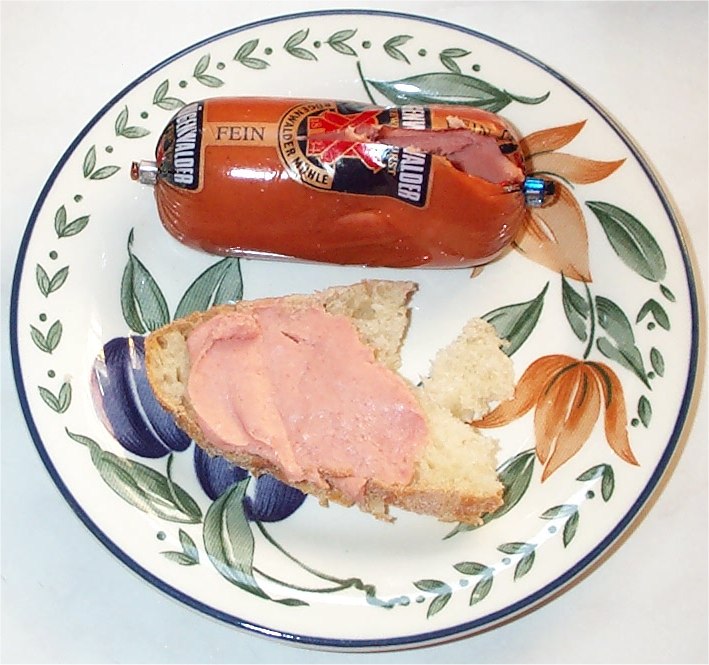Teewurst on:
[Wikipedia]
[Google]
[Amazon]
Teewurst () is a German  Teewurst was invented in
Teewurst was invented in History
/ref>
sausage
A sausage is a type of meat product usually made from ground meat—often pork, beef, or poultry—along with salt, spices and other flavourings. Other ingredients, such as grains or breadcrumbs may be included as fillers or extenders.
...
made from two parts raw pork
Pork is the culinary name for the meat of the domestic pig (''Sus domesticus''). It is the most commonly consumed meat worldwide, with evidence of pig husbandry dating back to 5000 BCE.
Pork is eaten both freshly cooked and preserved; ...
(and sometimes beef
Beef is the culinary name for meat from cattle (''Bos taurus'').
In prehistoric times, humankind hunted aurochs and later domesticated them. Since that time, numerous breeds of cattle have been bred specifically for the quality or quantity ...
) and one part bacon
Bacon is a type of salt-cured pork made from various cuts, typically the belly or less fatty parts of the back. It is eaten as a side dish (particularly in breakfasts), used as a central ingredient (e.g., the bacon, lettuce, and tomato sand ...
; they are minced, seasoned and packed in casings (mostly porous artificial casings) before being smoked
Smoking is the process of flavoring, browning, cooking, or preserving food by exposing it to smoke from burning or smoldering material, most often wood. Meat, fish, and ''lapsang souchong'' tea are often smoked.
In Europe, alder is the tradi ...
over beech
Beech (''Fagus'') is a genus of deciduous trees in the family Fagaceae, native to temperate Europe, Asia, and North America. Recent classifications recognize 10 to 13 species in two distinct subgenera, ''Engleriana'' and ''Fagus''. The ''Engle ...
wood. The sausage then has to mature for seven to ten days in order to develop its typical taste. Teewurst contains 30 to 40 percent fat, which makes it particularly easy to spread.
 Teewurst was invented in
Teewurst was invented in Pomerania
Pomerania ( pl, Pomorze; german: Pommern; Kashubian: ''Pòmòrskô''; sv, Pommern) is a historical region on the southern shore of the Baltic Sea in Central Europe, split between Poland and Germany. The western part of Pomerania belongs to ...
, probably in the small Baltic
Baltic may refer to:
Peoples and languages
* Baltic languages, a subfamily of Indo-European languages, including Lithuanian, Latvian and extinct Old Prussian
*Balts (or Baltic peoples), ethnic groups speaking the Baltic languages and/or originati ...
town of Rügenwalde (now Darłowo
Darłowo (Polish pronunciation: ; ; ), in full The Royal City of Darłowo ( pl, Królewskie Miasto Darłowo), is a seaside town in the West Pomeranian Region, at the south coast of the Baltic Sea, north-western Poland, with 13,324 inhabitants as ...
, Poland), in the middle of the 19th century. The name, which means ''tea sausage'', is said to derive from the habit of serving it in sandwiches at teatime.
Up to 1945, the sausage industry in Rügenwalde was well established, and Teewurst was its best-known product. In 1927, the term ''Rügenwalder Teewurst'' was declared a protected designation of origin
The protected designation of origin (PDO) is a type of geographical indication of the European Union and the United Kingdom aimed at preserving the designations of origin of food-related products. The designation was created in 1992 and its main ...
. After World War II
World War II or the Second World War, often abbreviated as WWII or WW2, was a world war that lasted from 1939 to 1945. It involved the vast majority of the world's countries—including all of the great powers—forming two opposin ...
, sausage makers from Rügenwalde fled or were expelled to the Federal Republic of Germany
Germany,, officially the Federal Republic of Germany, is a country in Central Europe. It is the second most populous country in Europe after Russia, and the most populous member state of the European Union. Germany is situated between ...
, where they established new companies and resumed the production of Teewurst. They established an association of former Rügenwald sausage makers, which registered the trademark ''Rügenwalder Teewurst'' in 1957. Teewurst was also made in East Germany
East Germany, officially the German Democratic Republic (GDR; german: Deutsche Demokratische Republik, , DDR, ), was a country that existed from its creation on 7 October 1949 until its dissolution on 3 October 1990. In these years the state ...
, but the brand ''Rügenwalder Teewurst'' was never used there. Today, only companies that once had their headquarters in Rügenwalde are allowed to use the term ''Rügenwalder Teewurst''. All others use the terms ''Teewurst'' or ''Rügenwalde-style Teewurst''./ref>
See also
*Ham sausage
Ham sausage is a sausage prepared using ham and other ingredients, the latter varying by location. It is a part of the cuisines of China, Germany, Poland and the United States. Ham sausage is a mass-produced food product.
By country China
Auto ...
* List of smoked foods
This is a list of smoked foods. Smoking is the process of flavoring, cooking, or preserving food by exposing it to smoke from burning or smoldering material, most often wood. Foods have been smoked by humans throughout history. Meats and fish a ...
*
References
Bibliography
* German sausages Smoked meat Raw sausages {{germany-sausage-stub